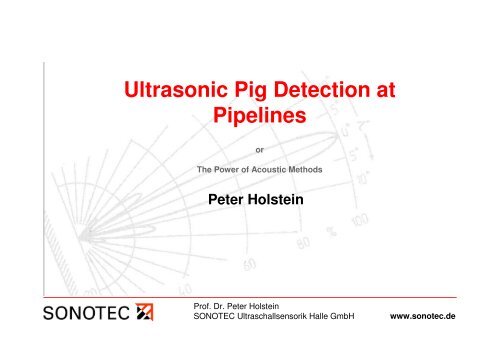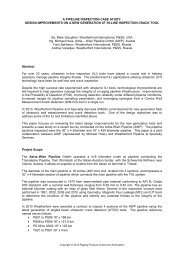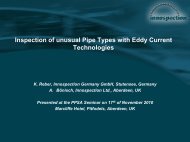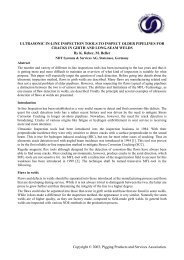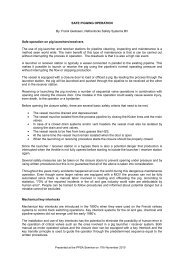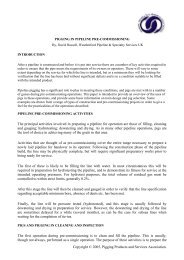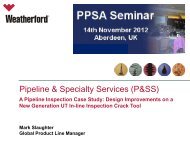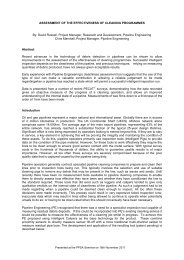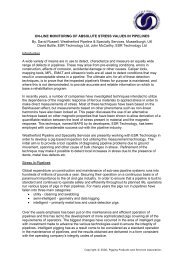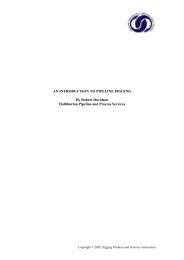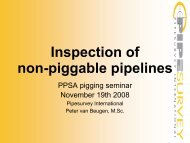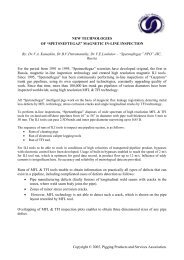Ultrasonic Pig Detection at Pipelines - PPSA, the Pigging Products ...
Ultrasonic Pig Detection at Pipelines - PPSA, the Pigging Products ...
Ultrasonic Pig Detection at Pipelines - PPSA, the Pigging Products ...
You also want an ePaper? Increase the reach of your titles
YUMPU automatically turns print PDFs into web optimized ePapers that Google loves.
<strong>Ultrasonic</strong> <strong>Pig</strong> <strong>Detection</strong> <strong>at</strong><br />
<strong>Pipelines</strong><br />
or<br />
The Power of Acoustic Methods<br />
Peter Holstein<br />
Prof. Dr. Peter Holstein<br />
SONOTEC Ultraschallsensorik Halle GmbH www.sonotec.de
SONOTEC – The Ultrasound Specialist<br />
SONOTEC Ultraschallsensorik<br />
Halle GmbH<br />
Nauendorfer Straße 2<br />
D-06112 Halle<br />
Deutschland<br />
Tel.: +49 (0) 3 45-1 33 17-0<br />
Fax.: +49 (0) 3 45-1 33 17-99<br />
Email: sonotec@sonotec.de<br />
www: http://www.sonotec.de<br />
Prof. Dr. Peter Holstein<br />
SONOTEC Ultraschallsensorik Halle GmbH www.sonotec.de
Fundamentals<br />
Frequencies for acoustic and ultrasonic engineering solutions<br />
Technical<br />
acoustics<br />
& vibr<strong>at</strong>ions<br />
Sound emission<br />
(„passive“)<br />
NDT<br />
non-destructive<br />
testing<br />
& “active” US<br />
Prof. Dr. Peter Holstein<br />
SONOTEC Ultraschallsensorik Halle GmbH www.sonotec.de
Basic Effects<br />
Propag<strong>at</strong>ion / Sound fields<br />
→ estim<strong>at</strong>ion of travel times<br />
→ <strong>at</strong>tenu<strong>at</strong>ion<br />
Sound speed depends on m<strong>at</strong>erial<br />
Prof. Dr. Peter Holstein<br />
SONOTEC Ultraschallsensorik Halle GmbH www.sonotec.de
Basic Effects<br />
→ Diffraction<br />
→ Reflection<br />
→ propag<strong>at</strong>ion of waves<br />
→ m<strong>at</strong>erial properties<br />
→ surfaces / geometry<br />
sinα1<br />
c<br />
=<br />
sinα<br />
c<br />
2<br />
→ (Back- )Sc<strong>at</strong>tering e.g.<br />
Doppler-Effect in Fluids<br />
→ Refraction<br />
1<br />
2<br />
Prof. Dr. Peter Holstein<br />
SONOTEC Ultraschallsensorik Halle GmbH www.sonotec.de
important formula<br />
(simplified)<br />
m<strong>at</strong>erial dependent !<br />
Source: Helke, Piezoelektrische Keramiken, TAE 2008, page 21<br />
m<strong>at</strong>erial density (kgm -3 ) sound velocity (ms -1 ) impedance (kgm -2 s -1 )<br />
steel 7850 5920 3.92·10 7<br />
w<strong>at</strong>er 1000 1484 1.48·10 6<br />
air (1 bar) 1.04 343 4.13·10 2<br />
Prof. Dr. Peter Holstein<br />
SONOTEC Ultraschallsensorik Halle GmbH www.sonotec.de
Applic<strong>at</strong>ions for <strong>Ultrasonic</strong> Probes<br />
→ Non-intrusive m<strong>at</strong>erial testing<br />
→ Autom<strong>at</strong>ion<br />
→ Process measurement techniques<br />
→ Medical technologies<br />
→ Consumer techniques<br />
Prof. Dr. Peter Holstein<br />
SONOTEC Ultraschallsensorik Halle GmbH www.sonotec.de
Requirements for <strong>Ultrasonic</strong> Probes<br />
→ Acoustic parameters<br />
→ Constructive parameters<br />
→ Electric parameters<br />
→ Applic<strong>at</strong>ion specific parameters<br />
→ Economic parameters<br />
→ Design<br />
- Sound field characteristic<br />
- Oper<strong>at</strong>ing frequency<br />
- Sensitivity<br />
- Signal-to-noise r<strong>at</strong>io<br />
- Acoustic impedance<br />
- Pulse shape<br />
- Focusing<br />
- M<strong>at</strong>erial resistance<br />
- Pressure resistance<br />
- Radi<strong>at</strong>ion resistance<br />
- Explosion-proof version<br />
Prof. Dr. Peter Holstein<br />
SONOTEC Ultraschallsensorik Halle GmbH www.sonotec.de
Selection of Industrial <strong>Ultrasonic</strong> Probes<br />
from left:<br />
contact technique, immersion, mini<strong>at</strong>ur, multi-channel, low frequency,<br />
phased-array, angle transmitter-receiver<br />
Prof. Dr. Peter Holstein<br />
SONOTEC Ultraschallsensorik Halle GmbH www.sonotec.de
Applic<strong>at</strong>ions<br />
limit switch<br />
object detection<br />
(e.g. pigs)<br />
Prof. Dr. Peter Holstein<br />
SONOTEC Ultraschallsensorik Halle GmbH www.sonotec.de
Applic<strong>at</strong>ions in Pipeline Industry and Service (selection)<br />
Active pulse methods<br />
→ Liquid level estim<strong>at</strong>ion<br />
→ Recognition of different liquids<br />
→ Measurement of wall thickness<br />
→ Level limits<br />
→ Inspection and monitoring of sediment<strong>at</strong>ion and deposits<br />
→ Measurement of <strong>the</strong> accumul<strong>at</strong>ion of sand, debris,<br />
incrust<strong>at</strong>ion in tanks, pipelines, barrels<br />
→ Advanced NDT-tasks (e.g. „intelligent“ pigging, m<strong>at</strong>erial<br />
testing)<br />
Prof. Dr. Peter Holstein<br />
SONOTEC Ultraschallsensorik Halle GmbH www.sonotec.de
Passive Sound Emission Methods<br />
→ Acoustic detection of moving sand in pipelines<br />
→ Amount of debris<br />
→ Condens<strong>at</strong>e inspection (e.g. in valves and traps)<br />
→ <strong>Detection</strong> of leakages<br />
→ Flowing sand and debris in pipelines<br />
→ Monitoring of m<strong>at</strong>erials and constructions<br />
Prof. Dr. Peter Holstein<br />
SONOTEC Ultraschallsensorik Halle GmbH www.sonotec.de
Typical Industrial Applic<strong>at</strong>ions<br />
Measurement through <strong>the</strong> wall<br />
left: level control of liquids (travel time and intensity are used for <strong>the</strong><br />
estim<strong>at</strong>ion of filling heights or for <strong>the</strong> control of defined filling levels)<br />
right: measurement of wall thickness (travel time of <strong>the</strong> echo(s))<br />
Prof. Dr. Peter Holstein<br />
SONOTEC Ultraschallsensorik Halle GmbH www.sonotec.de
<strong>Pig</strong> <strong>Detection</strong> in Oil <strong>Pipelines</strong><br />
Standard configur<strong>at</strong>ion of a transmitting ultrasonic probe for <strong>the</strong><br />
applic<strong>at</strong>ion <strong>at</strong> crude oil pipelines<br />
Prof. Dr. Peter Holstein<br />
SONOTEC Ultraschallsensorik Halle GmbH www.sonotec.de
… in Gas <strong>Pipelines</strong><br />
Active <strong>Ultrasonic</strong>s<br />
Principle of pig signalling by means of an <strong>at</strong>tenu<strong>at</strong>ion technique<br />
1 2<br />
→ The probes are radially arranged on <strong>the</strong> circumference<br />
→ <strong>Ultrasonic</strong> pulses via probe 1 (→ multi-reflections)<br />
→ Enhanced <strong>at</strong>tenu<strong>at</strong>ion (probe 2) in <strong>the</strong> moment of pig passing<br />
right: lab exp. (intensity of echo vs. time)<br />
Prof. Dr. Peter Holstein<br />
SONOTEC Ultraschallsensorik Halle GmbH www.sonotec.de
Active <strong>Ultrasonic</strong> <strong>Detection</strong><br />
Field experiment (cleaning pig run)<br />
peak-to-peak voltage (V)<br />
0.3<br />
0.28<br />
0.26<br />
0.24<br />
0.22<br />
0.2<br />
0.18<br />
0.16<br />
0.14<br />
0.12<br />
0.1<br />
0 500 1000<br />
time (s)<br />
1500 2000<br />
The baseline is also affected since <strong>the</strong> inner side of <strong>the</strong> wall has been<br />
influenced by residual oil collected by <strong>the</strong> pig in th<strong>at</strong> pipeline.<br />
Prof. Dr. Peter Holstein<br />
SONOTEC Ultraschallsensorik Halle GmbH www.sonotec.de
Passive Acoustics<br />
Sound Emission as <strong>Pig</strong> Signalling Tool<br />
Typical sensor install<strong>at</strong>ions<br />
(for permanent oper<strong>at</strong>ion<br />
or for temporary service)<br />
Schem<strong>at</strong>ic sketch of a typical situ<strong>at</strong>ion <strong>at</strong> pig receiver trap of a gas pipeline. The<br />
sensors are axially arranged (in contrast to <strong>the</strong> „active“ method ).<br />
Prof. Dr. Peter Holstein<br />
SONOTEC Ultraschallsensorik Halle GmbH www.sonotec.de
Real-time<br />
Correl<strong>at</strong>ion of<br />
an acoustic signal<br />
voltage (V)<br />
0.08<br />
0.06<br />
0.04<br />
0.02<br />
0<br />
-0.02<br />
-0.04<br />
-0.06<br />
-0.08<br />
2.7 2.75 2.8 2.85 2.9 2.95 3<br />
time (s )<br />
1.5<br />
correl<strong>at</strong>ion 1 (S1,S2)<br />
sensor 1<br />
0.08<br />
0.06<br />
0.04 sensor 2<br />
2.7 2.75 2.8 2.85 2.9 2.95 3<br />
time (s )<br />
(Excit<strong>at</strong>ion by means of a (low intensity) hammer pulse <strong>at</strong> sensor 1,<br />
sensor 2 in a distance of about 10 m).<br />
The dashed line illustr<strong>at</strong>es <strong>the</strong> lag of <strong>the</strong> shift.<br />
voltage (V)<br />
2<br />
0.5<br />
0<br />
-0.5<br />
-1<br />
-1.5<br />
-2<br />
voltage (V)<br />
Prof. Dr. Peter Holstein<br />
SONOTEC Ultraschallsensorik Halle GmbH www.sonotec.de<br />
0.02<br />
0<br />
-0.02<br />
-0.04<br />
-0.06<br />
-0.08<br />
-0.25 -0.2 -0.15 -0.1 -0.05 0 0.05 0.1 0.15 0.2 0.25<br />
time (s)
Spectral Behaviour of Pipeline Noise<br />
a m p litu d e (V)<br />
10 -1<br />
10 -2<br />
10 -3<br />
10 -4<br />
10 -5<br />
10 -6<br />
10 -7<br />
10 -8<br />
gas flow only<br />
0 2 4 6 8 10 12<br />
x 10 4<br />
frequency (Hz)<br />
a m p litu d e (V)<br />
10 -1<br />
10 -2<br />
10 -3<br />
10 -4<br />
10 -5<br />
10 -6<br />
10 -7<br />
10 -8<br />
additional<br />
unknown mechanical<br />
sources<br />
of noise<br />
0 2 4 6 8 10 12<br />
x 10 4<br />
frequency (Hz)<br />
a m plitude (V)<br />
10 -1<br />
10 -2<br />
10 -3<br />
10 -4<br />
10 -5<br />
10 -6<br />
10 -7<br />
friction noise<br />
of a passing pig<br />
0 2 4 6 8 10 12<br />
x 10 4<br />
frequency (Hz)<br />
Frequency characteristics (5 s intervals) of noise during a pig run in a (gas<br />
transport<strong>at</strong>ion) pipeline<br />
The clearly enhanced signal part <strong>at</strong> ultrasonic frequencies is obvious<br />
when a moving pig passes <strong>the</strong> sensor position.<br />
Prof. Dr. Peter Holstein<br />
SONOTEC Ultraschallsensorik Halle GmbH www.sonotec.de
A Complete Scenario<br />
vo lta g e (V)<br />
0.35<br />
0.3<br />
0.25<br />
0.2<br />
0.15<br />
0.1<br />
0.05<br />
0<br />
0 500 1000 1500 2000 2500 3000<br />
time (s)<br />
vo lta g e (V)<br />
x 10-3<br />
20<br />
18<br />
16<br />
14<br />
12<br />
10<br />
8<br />
6<br />
4<br />
2<br />
0<br />
0 500 1000 1500 2000 2500 3000<br />
Long time recording of <strong>the</strong> acoustic signals (cleaning pig, 900 mm pipeline diameter, unco<strong>at</strong>ed) received<br />
<strong>at</strong> <strong>the</strong> sensors 1 and 2 – left: r.m.s. (root mean square) signal without filtering,<br />
middle: <strong>the</strong> pig passage (unfiltered) <strong>at</strong> sensor 1. This signal in <strong>the</strong> proximity of <strong>the</strong> pig receiver results from a<br />
fairly complic<strong>at</strong>ed motion. There is no smooth travel of <strong>the</strong> pig. It moves r<strong>at</strong>her in a stick-slip-procedure<br />
which makes it impossible to use a „simple“ level indic<strong>at</strong>or as an alarm for a passage.<br />
right: <strong>the</strong> same recording but re-calcul<strong>at</strong>ed with a filter for ultrasonic frequencies. Consequently, <strong>the</strong><br />
intensity is drastically reduced but still sufficient. Fur<strong>the</strong>rmore, „longe range“ distortions can be elimin<strong>at</strong>ed<br />
more effectively.<br />
time (s)<br />
Prof. Dr. Peter Holstein<br />
SONOTEC Ultraschallsensorik Halle GmbH www.sonotec.de
<strong>Ultrasonic</strong> Signal during Passage of a <strong>Pig</strong><br />
v o lta g e (V )<br />
x 10-3<br />
20<br />
18<br />
16<br />
14<br />
12<br />
10<br />
8<br />
6<br />
4<br />
2<br />
0<br />
2500 2520 2540 2560 2580 2600<br />
time (s)<br />
v o lta g e (V)<br />
x 10-3<br />
20<br />
18<br />
16<br />
14<br />
12<br />
10<br />
8<br />
6<br />
4<br />
2<br />
0<br />
2500 2520 2540 2560 2580 2600<br />
time (s)<br />
v o lta g e (V )<br />
8<br />
6<br />
4<br />
2<br />
0<br />
-2<br />
-4<br />
-6<br />
x 10 -3<br />
2500 2520 2540 2560 2580 2600<br />
time (s)<br />
The digitally r.m.s. filtered signals (20 ...60 kHz) of <strong>the</strong><br />
passing pig <strong>at</strong> sensor 1 (left) and 2 (middle). The difference (right) signal<br />
(which is <strong>the</strong> source for <strong>the</strong> alarm) is fed into an integr<strong>at</strong>ion algorithm.<br />
Prof. Dr. Peter Holstein<br />
SONOTEC Ultraschallsensorik Halle GmbH www.sonotec.de
voltage (V)<br />
voltage (V)<br />
0.2<br />
0.18<br />
0.16<br />
0.14<br />
0.12<br />
0.1<br />
0.08<br />
0.06<br />
0.04<br />
0.02<br />
0<br />
0<br />
0.05<br />
200 400 600 800<br />
time (s)<br />
1000 1200 1400<br />
0.045<br />
0.04<br />
0.035<br />
0.03<br />
0.025<br />
0.02<br />
0.015<br />
0.01<br />
0.005<br />
0<br />
0 200 400 600<br />
time (s)<br />
800 1000 1200<br />
voltage (V)<br />
volta g e (V)<br />
0.05<br />
0.045<br />
0.04<br />
0.035<br />
0.03<br />
0.025<br />
0.02<br />
0.015<br />
0.01<br />
0.005<br />
0<br />
1088 1088.5 1089 1089.5<br />
time (s)<br />
1090 1090.5 1091<br />
0.2<br />
0.18<br />
0.16<br />
0.14<br />
0.12<br />
0.1<br />
0.08<br />
0.06<br />
0.04<br />
0.02<br />
0<br />
968 969 970 971<br />
time (s)<br />
972 973<br />
volta ge (V)<br />
voltage (V)<br />
0.2<br />
0.18<br />
0.16<br />
0.14<br />
0.12<br />
0.1<br />
0.08<br />
0.06<br />
0.04<br />
0.02<br />
0.05<br />
0.045<br />
0.04<br />
0.035<br />
0.03<br />
0.025<br />
0.02<br />
0.015<br />
0.01<br />
0.005<br />
0<br />
1088 1088.5 1089 1089.5<br />
time (s)<br />
1090 1090.5 1091<br />
0<br />
968 969 970 971<br />
time (s)<br />
972 973<br />
1088 1088.5 1089 1089.5 1090 1090.5 1091<br />
time (s)<br />
Prof. Dr. Peter Holstein<br />
SONOTEC Ultraschallsensorik Halle GmbH www.sonotec.de<br />
volta ge (V)<br />
0.08<br />
0.06<br />
0.04<br />
0.02<br />
0<br />
-0.02<br />
-0.04<br />
-0.06<br />
-0.08<br />
vo lta g e (V)<br />
x 10-3<br />
14<br />
12<br />
10<br />
8<br />
6<br />
4<br />
2<br />
0<br />
-2<br />
-4<br />
-6<br />
-8<br />
968 969 970 971 972 973<br />
time (s)<br />
Two fur<strong>the</strong>r examples of caliper and cleaning pig runs (in <strong>the</strong> same<br />
campaign / identical sensor positions)<br />
The ultrasonic signal is given only.
Elimin<strong>at</strong>ion of distortions<br />
v o lt a g e ( V )<br />
x 10-3<br />
20<br />
18<br />
16<br />
14<br />
12<br />
10<br />
8<br />
6<br />
4<br />
2<br />
0<br />
1120 1122 1124 1126 1128 1130<br />
time (s)<br />
v o lt a g e ( V )<br />
x 10-3<br />
20<br />
18<br />
16<br />
14<br />
12<br />
10<br />
8<br />
6<br />
-1<br />
4<br />
-2<br />
2<br />
0<br />
-3<br />
1120 1122 1124 1126<br />
time (s)<br />
1128<br />
-4<br />
1130 1120 1122 1124 1126<br />
time (s)<br />
1128 1130<br />
Calibr<strong>at</strong>ion of probes and choosing <strong>the</strong> „right“ integr<strong>at</strong>ion time -<br />
Signals from distant sources (even with complic<strong>at</strong>e signal p<strong>at</strong>terns) can be “easily” removed by suitable<br />
filters or algorithms. The distortions of o<strong>the</strong>r noisy sources such as rain can be suppressed, too.<br />
v o lt a g e ( V )<br />
x 10-3<br />
6<br />
5<br />
4<br />
3<br />
2<br />
1<br />
0<br />
Prof. Dr. Peter Holstein<br />
SONOTEC Ultraschallsensorik Halle GmbH www.sonotec.de
A Complete Example<br />
voltage (V)<br />
0.12<br />
0.1<br />
0.08<br />
0.06<br />
0.04<br />
0.02<br />
0<br />
0 200 400 600 800 1000 1200<br />
time (s)<br />
Prof. Dr. Peter Holstein<br />
SONOTEC Ultraschallsensorik Halle GmbH www.sonotec.de
Passage vs. Distortions<br />
voltage (V) voltage (V) voltage (V)<br />
0.1<br />
0.05<br />
0.05<br />
0<br />
818 820 822 824 826 828 830<br />
0.1<br />
time (s)<br />
0<br />
818<br />
0.04<br />
820 822 824 826 828 830<br />
0.02<br />
0<br />
-0.02<br />
time (s)<br />
-0.04<br />
818 820 822 824 826 828 830<br />
time (s)<br />
Prof. Dr. Peter Holstein<br />
SONOTEC Ultraschallsensorik Halle GmbH www.sonotec.de
Combin<strong>at</strong>ion of Methods<br />
Highly flexible d<strong>at</strong>a processing tools and alarm functions!<br />
Prof. Dr. Peter Holstein<br />
SONOTEC Ultraschallsensorik Halle GmbH www.sonotec.de
Conclusions<br />
→ acoustical technologies are powerful and vers<strong>at</strong>ile for <strong>the</strong> applic<strong>at</strong>ion<br />
in pig detection and signalling<br />
→ new applic<strong>at</strong>ions of ultrasonic methods for pig detection purposes<br />
→ no a priori knowledge about <strong>the</strong> type of <strong>the</strong> pig and <strong>the</strong> oper<strong>at</strong>ional<br />
conditions is necessary<br />
→ improvement of reliability by a combin<strong>at</strong>ion of different acoustical<br />
techniques<br />
→ increased onboard calcul<strong>at</strong>ion power and new algorithms<br />
→ <strong>the</strong> method carries <strong>the</strong> potential to be extended to pig localiz<strong>at</strong>ion<br />
We believe, th<strong>at</strong> <strong>the</strong> potential of <strong>the</strong> use of ultrasonic techniques<br />
is still underestim<strong>at</strong>ed in <strong>the</strong> pipeline and pigging sector as well.<br />
Prof. Dr. Peter Holstein<br />
SONOTEC Ultraschallsensorik Halle GmbH www.sonotec.de
Acknowledgements<br />
For financial support, <strong>the</strong> Ministry of Employment and Economic Affairs of <strong>the</strong> Federal St<strong>at</strong>e<br />
Saxony-Anhalt (Germany) is gr<strong>at</strong>efully acknowledged (grant 0804/0009; 2007-2010). We<br />
thank VNG (Verbundgas AG Leipzig, Germany) for <strong>the</strong> support to enable <strong>the</strong> experimental<br />
work to continue.<br />
My special thank goes to <strong>the</strong> co-authors H.-J.Münch, S. zur Horst-Meyer, SONOTEC, A.<br />
Tharandt, University of Applied Sciences Leipzig, U. Bauerschäfer, L. Ledig, S. Gai, GMBU<br />
e.V. Halle.<br />
Thank you for your <strong>at</strong>tention!<br />
Prof. Dr. Peter Holstein<br />
SONOTEC Ultraschallsensorik Halle GmbH www.sonotec.de


